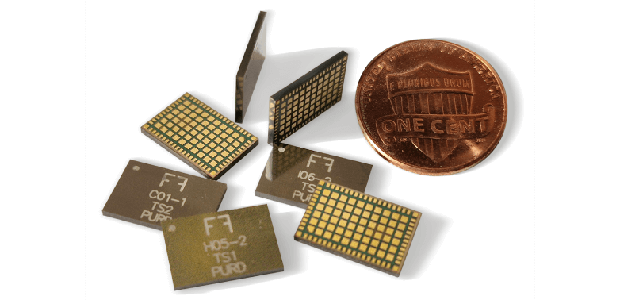
Cutting through the noise of RF complexity
Growing data usage on mobile networks has led to a growing number of RF frequency bands, in turn creating more components and greater in size. In summary, the more frequency bands there are, the more fixed frequency filters that are required in mobile radio front ends.
This may mean very little to the end smartphone user because frequency switching happens behind the scenes – when you switch provider, for instance, or visit another country – but for smartphone device manufacturers, more components and region-specific frequency bands has ultimately caused complexity in smartphone design. Founded in 2020, fabless semiconductor startup Forefront RF aims to solve this challenge.
“Leo Laughlin founded Forefront RF after nearly a decade of research into overcoming these challenges,” said CEO Ronald Wilting in an interview with Startups Magazine.
Wilting’s own background involved a fascination in the smartphone industry, “because of its fast pace and evolving nature”. He said that what began as a hobby evolved into a career when he joined Ericsson.
However, frustration with what he saw as a “slow-moving, cautious” enterprise world culminated in transitioning to working in the startup space, “an area I find both inspiring and exhilarating.”
In Forefront RF he saw a company addressing a critical issue and was appointed CEO in June 2022.
Adaptive RF
“The [mobile] industry has historically struggled with the need for multiple filters and switch banks in software defined radio systems to accommodate an ever-growing number of frequency bands,” explained Wilting.
According to Wilting: “the explosive growth in mobile data usage has driven the need for a vast array of frequency bands … this has forced manufacturers to develop region-specific variants, each requiring numerous RF components, creating significant space challenges and other complexities in software defined radio systems.”
Having set the scene, Forefront RF believes its technology, Foretune, is well-placed to address these challenges and complexities. Rather than using multiple components for different bands, the startup has developed an RF Front-End Control Interface (RFFE) module integrating a power amplifier, low-noise amplifier, coupler, and tunable duplexer – RFall capable of self-configuring to different frequency bands.
In other words, its module offers one component for smartphone manufacturers to integrate.
The development of the technology has not been easy. “RF development is inherently complex due to factors like signal integrity, interference, and regulatory requirements,” said Wilting. “One of our biggest challenges has been ensuring our adaptive RF solutions meet stringent performance criteria while remaining power efficient.”
Integrating multiple parts into one module has meant the startup had to weigh up internal and external development and make a strategic decision. “Due to market cost constraints, off-the-shelf components weren’t viable.”
However, this doesn’t negate the potential Wilting said he saw for Foretune. “Our technology is set to redefine the mobile manufacturing landscape by reducing necessary components, enabling more compact and efficient devices.
“We’ve developed successful prototypes and forged strong partnerships with manufacturing, and the future looks promising, particularly in the cellular-enabled smartwatch market, which is growing rapidly.”
Wearable devices present one example of where manufacturers are pressed for component space, and having fewer, more compact components is highly desirable. “Every mm of PCB space is precious,” added Wilting, “and expanding frequency band capabilities is essential for product longevity.”
An explosion in data is a challenge and opportunity
Data usage is only set to grow, as are 5G-enabled devices. Investment in the 5G rollout has been significant from companies who have seen the appeal of more bandwidth and lower latencies.
“This data explosion presents significant challenges for mobile device manufacturers,” Wilting warned. “Current filters and switch banks … are fixed frequency, meaning that as band counts rise, so does component and complexity. This trend is unsustainable.”
It’s not bad news for Forefront RF, though, who can present device manufacturers with a solution to simplify design.
“Our solution streamlines design by replacing existing components with a multiband module that self-configures according to available frequency bands, thus removing this complexity,” said Wilting. “It also removes the need for multiple product variants due to different regional band allocations.”
It is also helped by what Wilting saw as a lack of direct competition in their space. “Our Foretune technology is truly unique … Some of the larger players are attempting to overcome the RF band dilemma by developing end-to-end 5G modules, but these solutions are not without limitations: they are expensive to deploy, they don’t factor in legacy networks, and they are not future proof.”
Beyond a belief in its technology, the startup is structured around three teams, Wilting said, which has allowed them to continue to grow: software and algorithm development, measurement, and design and system. “I look for individuals who are not only technically skilled, but also adaptable, collaborative, and not afraid of challenges,” he explained. In how the company is set up, it facilitates “cross functional knowledge sharing and providing clear objectives.”
Since 2020, there have been several milestones validating Forefront RF’s capacity to solve a real-world problem: winning first place in the Cambridge Independent Science and Technology Awards in its ‘One to Watch’ category as well as featuring in The CEO Vision’s Top 50 Companies to Watch in 2024.
The next steps for the startup include focusing on commercial acceptance for its technology. “This means finalising the product’s performance, securing early design wins, strengthening existing partnerships, and forging new ones.
“Longer term, we are aiming to establish Forefront RF as a key enabler in the industry, scaling our technology to multiple applications, and making adaptive RF the new standard.”
This article originally appeared in the March/April 2025 issue of Startups Magazine. Click here to subscribe

